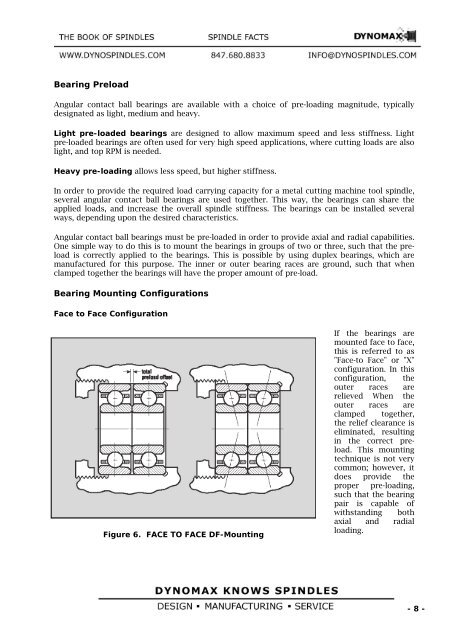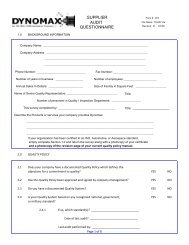You also want an ePaper? Increase the reach of your titles
YUMPU automatically turns print PDFs into web optimized ePapers that Google loves.
Bearing Preload<br />
Angular contact ball bearings are available with a choice of pre-loading magnitude, typically<br />
designated as light, medium and heavy.<br />
Light pre-loaded bearings are designed to allow maximum speed and less stiffness. Light<br />
pre-loaded bearings are often used for very high speed applications, where cutting loads are also<br />
light, and top RPM is needed.<br />
Heavy pre-loading allows less speed, but higher stiffness.<br />
In order to provide the required load carrying capacity for a metal cutting machine tool <strong>spindle</strong>,<br />
several angular contact ball bearings are used together. This way, the bearings can share the<br />
applied loads, and increase the overall <strong>spindle</strong> stiffness. The bearings can be installed several<br />
ways, depending upon the desired characteristics.<br />
Angular contact ball bearings must be pre-loaded in order to provide axial and radial capabilities.<br />
One simple way to do this is to mount the bearings in groups of two or three, such that the preload<br />
is correctly applied to the bearings. This is possible by using duplex bearings, which are<br />
manufactured for this purpose. The inner or outer bearing races are ground, such that when<br />
clamped together the bearings will have the proper amount of pre-load.<br />
Bearing Mounting Configurations<br />
Face to Face Configuration<br />
Figure 6. FACE TO FACE DF-Mounting<br />
If the bearings are<br />
mounted face to face,<br />
this is referred to as<br />
"Face-to Face" or "X"<br />
configuration. In this<br />
configuration, the<br />
outer races are<br />
relieved When the<br />
outer races are<br />
clamped together,<br />
the relief clearance is<br />
eliminated, resulting<br />
in the correct preload.<br />
This mounting<br />
technique is not very<br />
common; however, it<br />
does provide the<br />
proper pre-loading,<br />
such that the bearing<br />
pair is capable of<br />
withstanding both<br />
axial and radial<br />
loading.<br />
- 8 -



